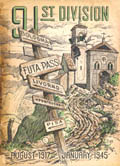|
|
|
Pg
1 |
|
|
Chapter I.
91ST DIVISION IN WORLD WAR I
FIVE MONTHS after the United States declared war on Germany in 1917, the
original 91st Infantry Division was activated at Camp Lewis, Washington. Most
of the men came from the states of the Northwest, a fact which explains many of
the distinctively western traditions and emblems which are part of the heritage
of the 91st Division of World War II. Activated under the command of Major
General H. A. Greene, the Division immediately plunged into training. The first
contingent, which arrived 5 September 1917, was so eager to begin that they
drilled in their civilian clothes.
After 10 months of training the Division made ready to go overseas. Examined and
reoutfitted at the staging area, Camp Merritt, New Jersey, the first elements
sailed for France 6 July 1918. Most of the men landed in England, although a few
were taken directly to France.
By 1 August the Infantry Brigades had been gathered at Montigny le Roi, and the
Artillery Brigade at Camp de Souge and Clermont-Ferrand. At these places the
men underwent a month of incessant drilling and long hours of marching, until
they were declared ready for actual combat. On 29 August Major General William
Johnston assumed command of the Division, and a very few days later, 7
September, it was assigned to the reserve of the First American Army during the
St. Mihiel offensive, with headquarters at Sorcy.
|
|
|
|
2 |
|
|
Combat
When the success of the St. Mihiel offensive was assured, the 91st entered the
Meuse-Argonne sector prepared to attack. Nearly every other Division employed in
the Meuse-Argonne had previous combat experience. The 91st had had no such
experience, yet it gave notable account of itself. On 25 September General John
J. Pershing, Commander-in-Chief of the Allied Armies, personally visited Major
General Johnston to express his confidence in the 91st before they marched into
battle. The next day the Division showed that General Pershing's confidence had
not been misplaced by breaking through two German lines and penetrating a third,
advancing 8 kilometers. The enemy was driven from the strong points of Very,
Epinonville, Gesnes, Eclis-fontaine, and Tronsol Farm. General George J.
Cameron, Commanding General, Fifth Corps, paid high tribute to the Division in
an order to General Johnston:
"At a time when the divisions on its flanks were faltering, and even falling
back, the 91st pushed ahead and steadfastly clung to every yard gained. In its
initial performance, your Division has established itself firmly in the list of
the Commander-in-Chief's reliable units. Please extend to your officers and men
my appreciation of their splendid behavior and my hearty congratulations on the
brilliant record they have made."
|
|
|
|
3 |
|
|
Despite the fact that this offensive was the Division's
first entrance into combat, it captured more artillery, machine guns, and
prisoners, and advanced a greater distance under fire than many Divisions with
much longer combat experience. On 4 October, the Division was relieved by the
32nd Division and assembled near Contrisson.
One of the great honors given the Division came on 16 October, when, along with
the 37th Division, it was named as part of the armies in Flanders, which, under
King Albert, were about to launch the final crushing drive at the enemy in
Belgium. The 91st attacked in the early morning mists of 31 October. From that
time on until the very moment of surrender, 11 AM on 11 November, the Division
drove the enemy back in panic. Although the enemy had been ordered to hold the
heights between the Lys and the Excaut Rivers to the death, the 91st smashed
them the first day, and by the evening of 1 November they were on the outskirts
of Audenande. The next day the town was secured, and the Division pushed on to
capture Welden, Petegem, and Kasteelwijk in rapid succession.
On the morning of 10 November, with the 182nd Infantry Brigade in the lead,
the Division crossed the Scheldt River near Eyne. They drove forward through
town after town, and had advanced beyond Moldergem when the order came to cease
firing. In recognition of the superb courage and fighting ability the 91st
Division had shown Major General De Goutte, who had resumed command of the Sixth
French Army, issued an order which read, in part:
|
|
|
|
4 |
|
|
“I have found the same spirit of duty and discipline freely given in the 37th
and 91st Divisions, United States Army, which
brings about valiant soldiers and victorious armies.
Glory to such troops and to such commanders. They have bravely contributed to
the liberation of a part of Belgian territory and to final victory.
The great nation to which they belong can be proud of them."
After the Armistice, elements of the 166th Field Artillery Brigade moved into
Germany and occupied the village of Wittlich until February 1919. The infantry
of the Division, after parading triumphantly with the men of the 37th before the
cheering crowds of Brussels, patrolled the Franco-Belgian border west of
Poperinghe from Beveren to Warande, for a short time. On 2 January the first
contingent of men sailed for home, and echelons sailed thereafter as
transportation became available. Division Headquarters, last to leave France,
sailed 6 April, and final demobilization of the Division was completed at camps
in California, Washington, and Wyoming by 14 May 1919.
![[91st Division, World War I]](pics/c1p1unknown.jpg)
[Note: Image illegible in original.]
|
|
|
|
|
|
![[Lone Sentry]](../pics/sentrysmall.jpg)
![[Lone Sentry: www.lonesentry.com]](../pics/lonesentrylogo.jpg)
![[Lone Sentry]](../pics/sentrysmall.jpg)
![[Lone Sentry: www.lonesentry.com]](../pics/lonesentrylogo.jpg)
